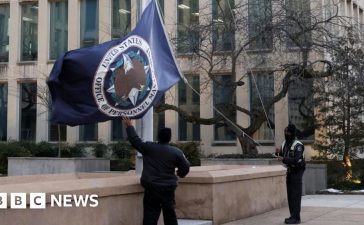In news that will likely surprise no-one, Britain’s average CEO is a 55-year-old privately educated white man who studied Economics at Cambridge and makes £4,196,000 a year.
Data from the FTSE100 – a list of the 100 biggest companies listed on the London Stock Exchange – has been used to work out the most common background for a UK CEO.
Researchers from People Managing People used artificial intelligence (AI) to combine the LinkedIn profile pictures of Britain’s top 100 CEOs.
The resulting composite image reveals the face of the average CEO – an oddly familiar man dubbed Andrew.
Finn Bartram, Editor of People Managing People, said the uncanny digital portrait shows the ‘undeniable privileges and gender disparities for the top jobs at some of the biggest companies in the country.’

Researchers used artificial intelligence (AI) to combine the LinkedIn profile pictures of Britain’s top 100 CEOs. The resulting composite image reveals the face of the average CEO – an oddly familiar man dubbed Andrew
The photos were combined using Midjourney’s blend function which allows users to submit two to five images as the prompt for a blended artificial image.
To get around the image limit, the 100 photos were broken into 20 groups of five images which were blended.
The resultant 20 images were then divided and blended, repeating the process until ‘Andrew’ was produced.
Andrew’s gender doesn’t come as much of a surprise as the data shows a massive male bias in top corporate positions.
Out of the UK’s top 100 CEOs, 88 are men and only 11 are women.
Shockingly, the research found that there are more male CEOs called Andrew or Simon than there are women in the top spots of the largest firms.
However, Mr Bartram did note that this is an improvement compared to previous years.
‘In 2020, there were just five female CEOs in the FTSE100, now there are 11,’ he said.

Only three CEOs in the FTSE100 didn’t attend university, according to the researchers. This includes Simon Roberts of Sainsburys, who worked his way up from store management positions in M&S and Boots
‘If this trend continues we could see the number of female CEOs reach parity with male CEOs by the end of the decade.’
For the women who make it to the top, there’s still a disparity, with female CEOs earning £3,371,000 on average – 23.5 per cent less than men.
Across the top CEOs, 66 per cent were privately educated, while Cambridge and Oxford were the most common choice of university, where 14 per cent of all the listed bosses got their degrees.
Only three CEOs in the FTSE100 didn’t attend university, according to the researchers.
This includes Simon Roberts of Sainsburys, who worked his way up from store management positions in M&S and Boots.
The research also highlights the staggering pay packets that some CEOs receive for making it to the top spots.
While the average CEO makes 127 times the average UK salary, the highest paid CEO, Pascal Soriot of AstraZeneca, makes three times that amount with a £15,323,000 a year deal.
To put this in perspective, if a CEO started work on Monday at 9:00am, they would have already made the average yearly salary of £33,000 by 9:20am on Wednesday morning.
The only notable exception to the rule was Michael Murray of Frasers Group, who has voluntarily given up his salary and makes £0 a year.
The team hopes the findings will encourage British firms to address privileges and gender disparity in the workplace.
‘To truly address privileges and gender disparity in the corporate world, we must commit to a multifaceted approach that includes equal opportunity, pay equity, mentorship, family-friendly policies, and transparency,’ Mr Bartram added.
‘It requires a sustained effort from all stakeholders to promote diversity and inclusion at every level of leadership.’
Speaking to MailOnline, Kelly Manthey, CEO of tech consultancy Kin & Carta, which is listed on the London Stock Exchange, said: ‘We all need role models who “see” us and who we can ‘see’ as having a shared experience.
‘It’s so important for women and any underrepresented group to have someone they can see.’












